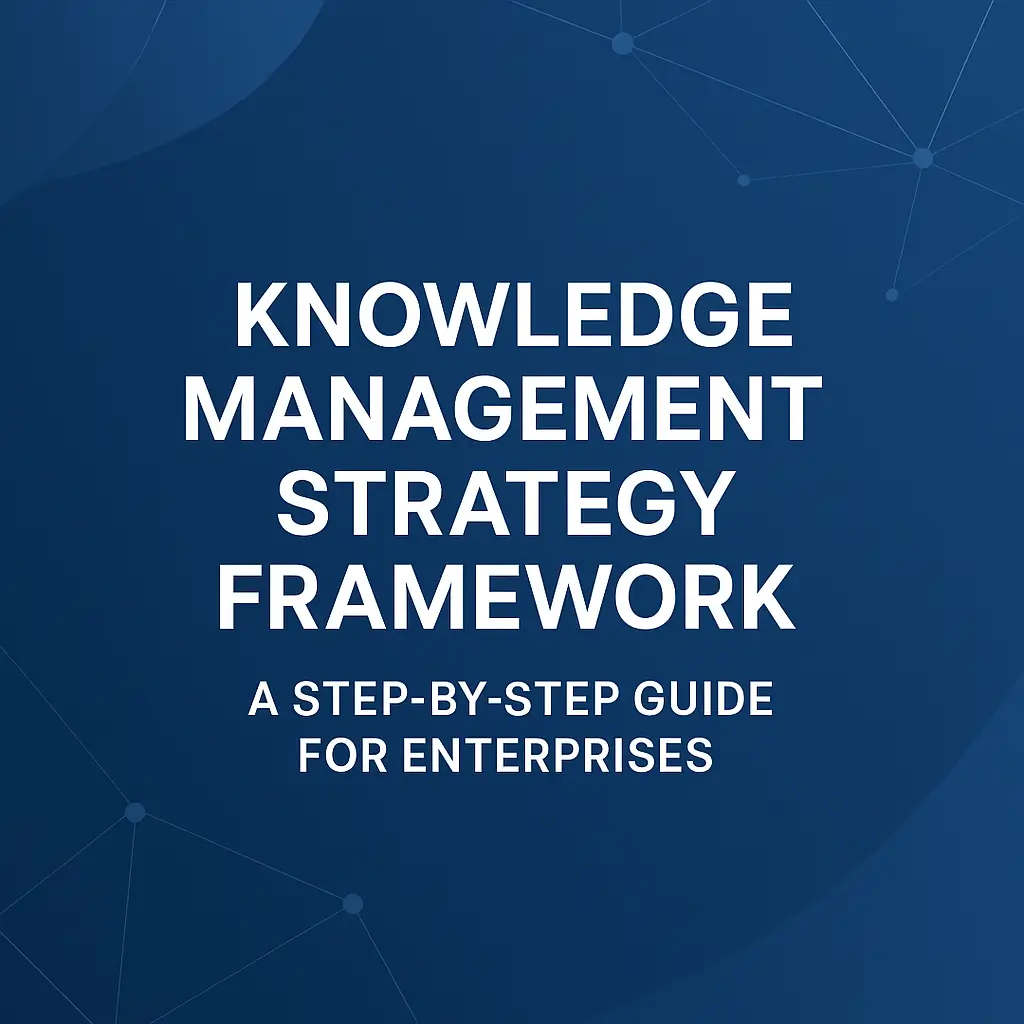In today’s information-driven world, knowledge is one of the most valuable assets an organization possesses. Yet, capturing, organizing, and applying knowledge effectively remains a persistent challenge for enterprises. This is where a Knowledge Management (KM) Strategy Framework becomes essential. A well-designed framework does more than organize information—it aligns knowledge initiatives with business objectives, ensures consistency, and drives measurable value across the organization.
This guide provides an in-depth look at what a KM strategy framework is, why it matters, and how global enterprises can design one that truly works.

What Is a Knowledge Management Strategy Framework?
A KM strategy framework is a structured blueprint that guides an organization in capturing, storing, sharing, and applying knowledge. Unlike ad-hoc KM initiatives, a framework provides a consistent methodology for turning information into actionable insights that improve decision-making, innovation, and operational efficiency.
At its core, a KM framework addresses three fundamental questions:
- What knowledge is critical for the organization?
- How should this knowledge be captured, stored, and shared?
- How will the organization measure the impact of its knowledge initiatives?
A robust KM framework does not just focus on technology or documentation. It integrates people, processes, and culture—ensuring knowledge flows seamlessly across teams and departments.
Why Enterprises Need a KM Strategy Framework
Even companies with extensive knowledge repositories often fail to fully leverage their information. A KM framework solves this problem by:
- Aligning Knowledge with Business Goals: Ensures KM initiatives support strategic priorities, whether it’s innovation, compliance, or operational efficiency.
- Enhancing Collaboration: Standardized processes reduce silos and make expertise easily discoverable.
- Improving Decision-Making: By structuring knowledge for easy retrieval and context-driven application, organizations reduce errors and accelerate decisions.
- Ensuring Consistency and Scalability: Templates, taxonomies, and workflows allow KM practices to scale across global teams without losing quality.
- Measuring Impact: Frameworks define metrics and KPIs to evaluate the success of KM initiatives, moving beyond anecdotal evidence to tangible business outcomes.
Global enterprises like IBM, Deloitte, and Microsoft have demonstrated that a structured KM framework directly contributes to productivity, innovation, and competitive advantage.
Core Components of a Successful KM Strategy Framework
To build a framework that delivers measurable value, organizations should focus on five key components:
1. Knowledge Governance
Define clear ownership, roles, and responsibilities for managing knowledge. Governance ensures that content is accurate, up-to-date, and compliant with regulatory requirements.
2. Knowledge Capture and Creation
Identify critical knowledge assets and standardize the processes for capturing both explicit (documents, manuals, databases) and tacit knowledge (expertise, insights). Tools like lessons learned templates, knowledge repositories, and collaborative platforms are essential.
3. Knowledge Organization and Taxonomy
Develop a structured classification system or taxonomy that makes knowledge easy to find. Semantic tagging, metadata standards, and category hierarchies help employees locate the right information without extensive searching.
4. Knowledge Sharing and Collaboration
Enable knowledge flow through collaboration tools, communities of practice, and cross-functional workflows. A culture that rewards knowledge sharing is just as important as technology.
5. Knowledge Application and Measurement
Ensure knowledge is applied to decisions, processes, and innovation. Establish KPIs such as time saved, error reduction, decision quality improvement, and knowledge reuse to quantify impact.
Step-by-Step Approach to Building a KM Strategy Framework
Building a KM framework requires careful planning, iterative design, and enterprise-wide alignment.
- Assess Current State
Conduct a knowledge audit to identify what knowledge exists, gaps, and silos. - Define Strategic Objectives
Link KM initiatives directly to business goals such as innovation, customer satisfaction, or operational efficiency. - Design the Framework
Include governance, capture, organization, sharing, and application processes. Ensure templates, taxonomies, and workflows are clearly defined. - Select Tools and Technologies
Choose platforms that support the framework—knowledge bases, collaborative tools, search engines, and analytics systems. - Implement and Train
Roll out the framework gradually, with training programs and support to encourage adoption across teams. - Measure, Review, and Optimize
Use KPIs and feedback loops to continuously improve the framework. Ensure it adapts to evolving business needs.
Case Studies from Leading Companies
- IBM: Uses a structured KM framework integrating AI-powered search and semantic tagging to make internal expertise globally discoverable.
- Deloitte: Applies lessons learned templates and structured knowledge repositories across projects to improve client advisory services.
- Microsoft: Leverages KM frameworks to streamline onboarding and internal process documentation, reducing duplication and improving productivity.
These examples show that a KM strategy framework is not just theoretical—it drives real, measurable business value.
Common Challenges and How to Overcome Them
- Cultural Resistance – Employees may resist sharing knowledge. Solution: incentivize participation and showcase benefits.
- Data Silos – Knowledge scattered across systems reduces effectiveness. Solution: unify repositories and integrate platforms.
- Overcomplicated Frameworks – Too much structure can hinder adoption. Solution: keep templates and taxonomies simple and intuitive.
- Lack of Measurement – Without KPIs, it’s hard to demonstrate impact. Solution: define clear metrics aligned with business goals.
Emerging Trends in KM Strategy Frameworks
- AI and Cognitive Search Integration – Using machine learning to enhance discoverability and recommendations.
- Decision Intelligence Alignment – Embedding knowledge into decision workflows for real-time action.
- Dynamic Taxonomies – Adaptive categorization systems that evolve with business needs.
- Collaborative Knowledge Networks – Leveraging communities of practice and social platforms to improve knowledge flow.
Conclusion
A Knowledge Management Strategy Framework is the blueprint that transforms knowledge from a static asset into a strategic driver. By combining governance, structured capture, organized storage, collaborative sharing, and measurable application, enterprises can unlock the full value of their knowledge.
Organizations that invest in designing, implementing, and continuously improving their KM frameworks gain not just efficiency, but agility, innovation, and a sustainable competitive advantage. For KM leaders, the key is to treat the framework as a living system—one that evolves alongside organizational needs and continues to deliver measurable results.
Read: Top 5 Knowledge Management Strategy Framework Models Every Organization Should Know
